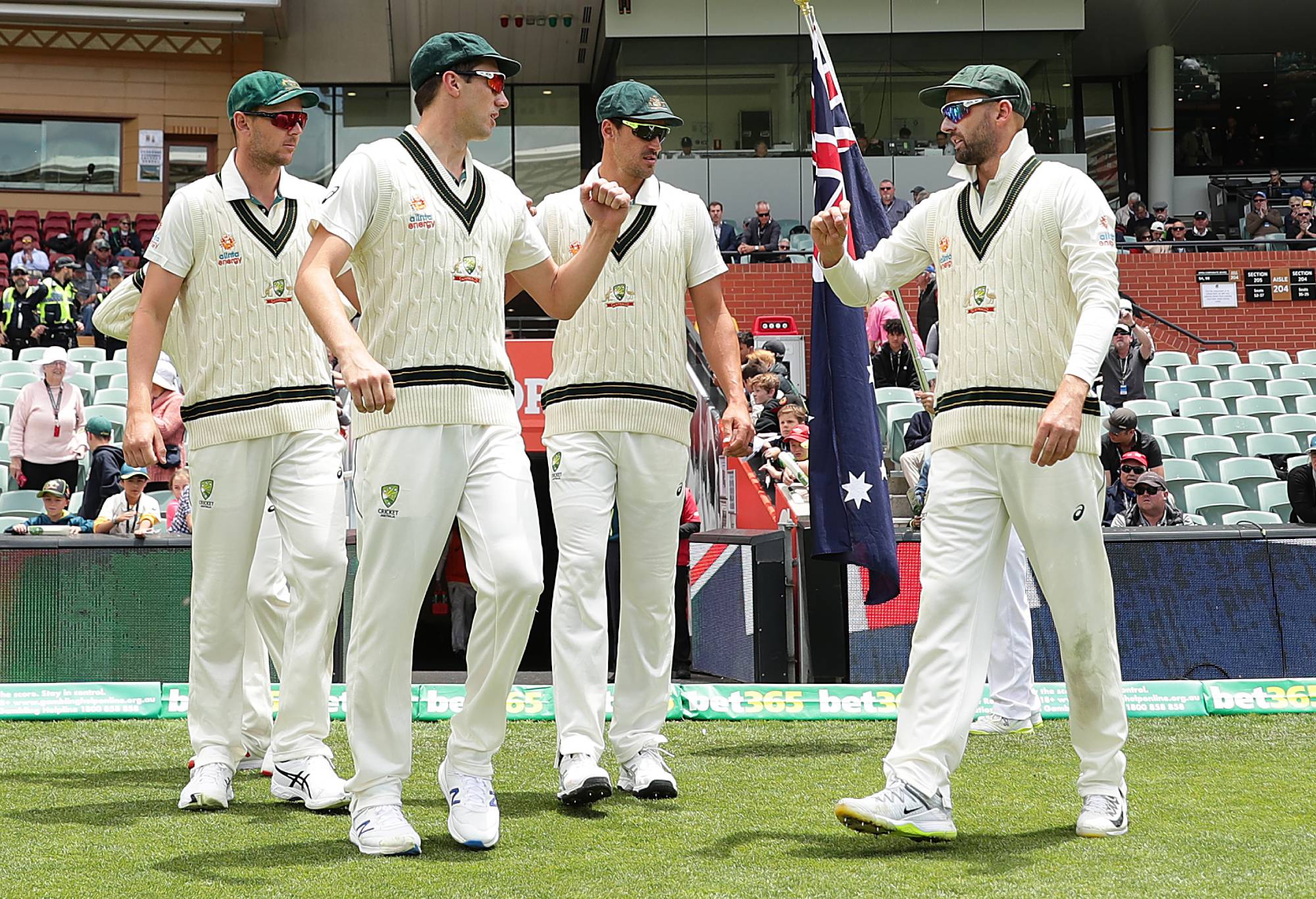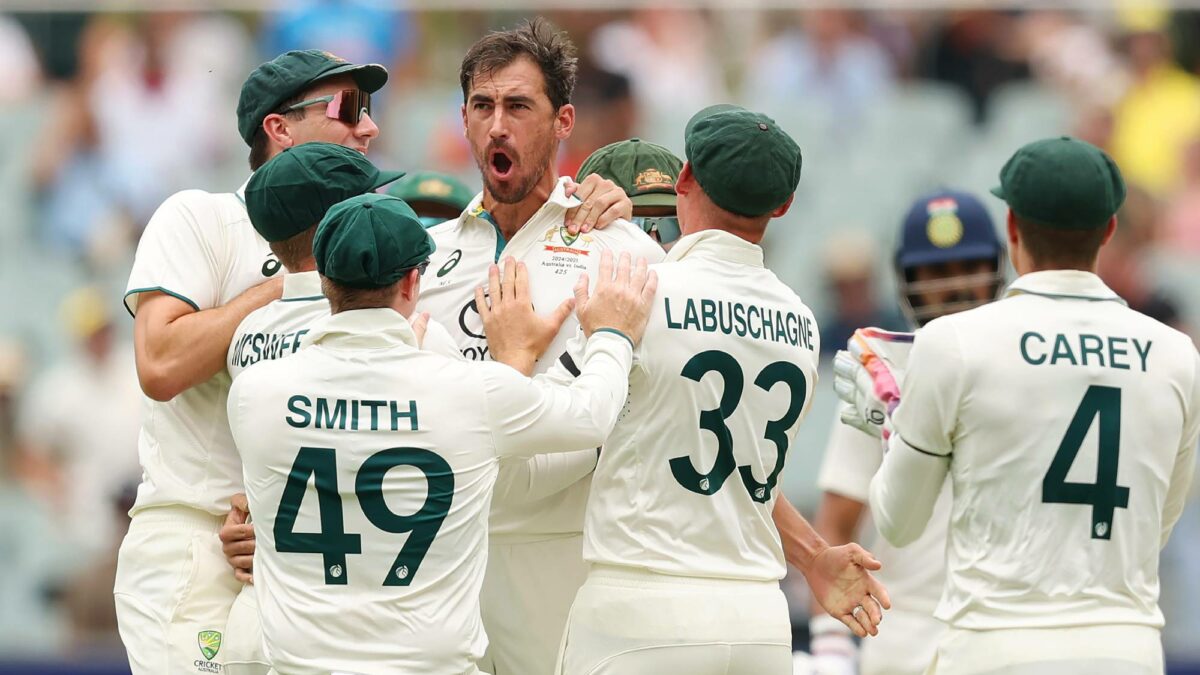Unassuming is a word that you are not supposed to associate with fast bowlers in Test cricket.
They’re supposed to be scary, in your face and scowling.
Mitchell Starc has gone against the grain by being mostly genial and not one for sledging, but he still strikes fear in the hearts of batters. And has done for nearly 15 years in the Test arena.
The third Test against the West Indies in Jamaica, which gets under way in the early hours of Sunday morning (AEST) will be his 100th, making him just the 16th Australian to achieve the feat.
He is just the fourth bowler and second quick behind Glenn McGrath to join the exclusive club.
In the history of Test cricket, only 10 quicks have reached a century of Tests with James Anderson’s 188 unlikely to be toppled with the long format not necessarily under an existential threat but unlikely to be played as frequently as the T20 revolution shows no sign of letting up.
Despite taking 395 wickets at 27.39 with 15 five-wicket hauls along the way to underline the fact that he is a proven match-winner, there are still critics who think the 35-year-old is a very good bowler who has lasted a long time rather than a great one.
When you stack his record up against the other eight fast bowlers with 250 or more Test wickets, Starc more than holds his own in that elite company.
Averaging four wickets per Test is the hallmark of a top-class performer, particularly when for the bulk of his career he has had Pat Cummins, Josh Hazlewood and Nathan Lyon also taking their fair share of victims.

Mitchell Starc celebrates after taking a wicket. (Photo by Santanu Banik/Speed Media/Icon Sportswire via Getty Images)
On the flip side, their four-way partnership has in many ways made it considerably easier for each other because there has been little respite for opposing batters.
If they get through Starc’s new-ball spell and manage to keep Hazlewood’s nagging seamers at bay, then Cummins comes on to ensure there is no let-up and Lyon is at the ready to offer a different kind of threat.
It’s not in the same league for fear and intimidation that the Windies used to have in their glory days of the 1970s and ‘80s when their pace quartet wrought havoc on opposing batters’ averages, careers and bone structures, but it’s been ultra effective for Australia.
Australia’s highest wicket-taking Test quicks
| Tests | Wickets | Avge | Strike Rate | |
| GD McGrath | 124 | 563 | 21.64 | 51.95 |
| MA Starc | 99 | 395 | 27.39 | 48.02 |
| DK Lillee | 70 | 355 | 23.92 | 52.01 |
| MG Johnson | 73 | 313 | 28.4 | 51.12 |
| B Lee | 76 | 310 | 30.81 | 53.32 |
| PJ Cummins | 70 | 307 | 22.16 | 45.99 |
| JR Hazlewood | 75 | 292 | 24.32 | 52.51 |
| CJ McDermott | 71 | 291 | 28.63 | 56.99 |
| JN Gillespie | 71 | 259 | 26.13 | 54.95 |
For a bowler who is seen as a strike weapon, one who is capable of producing a peach of a delivery even though he will occasionally spray a delivery or two wide, Starc’s career has been defined by his consistency.
After only playing 14 Tests for 45 wickets in his first four calendar years, he has taken 350 in the ensuing 85 matches through a combination of swing, speed and stamina.
Only once has he taken 50 wickets in a year, 2016 from eight Tests, but he has never had a bad stretch.
And he has been able to perform in all conditions, home and away.
He has 235 wickets from his 55 Tests on home soil at 26.46 and although his average is slightly higher overseas, he has performed well in all corners of the cricketing globe, a claim that not all fast bowlers can make.
His record in Asian conditions of 58 wickets from 19 matches at 28.75 is ultra impressive for any fast bowler, let alone one who grew up on much different wickets in Sydney.
“I’ve always had that air speed so at times that can take the pitch conditions out of the equation,” Starc told reporters in the lead-up to his milestone match at Sabina Park which will be played as a day-nighter with a pink ball, conditions that suit him to a tee.

Pat Cummins, Mitchell Starc, Josh Hazlewood and Nathan Lyon. (Photo by Mark Metcalfe – CA/Cricket Australia via Getty Images)
“Being left-handed is obviously a different point of angle or perception for the batter.
“It’s been enjoyable to play my role in different conditions and still be able to be impactful around the world.”
At 35, the end is in sight. Or is it?
Starc has been extraordinarily durable with no major injuries keeping him out of action throughout the course of his career.
He has sacrificed many millions by opting out of the IPL for all but four seasons of his career – the fact that he fetched $4.4m and $2.15m in the past two auctions underscores how much more he could have earned if he put T20 riches ahead of his national team duties.
As noble as his decision was to preserve his body for the Australian team over the extra riches he could have made on the IPL circuit, there will come a time in the near future where he will have to make a decision on his playing future or it will be made for him.
Despite the workload of representing Australia in three formats – he is up to 291 in short and long-form matches, he is yet to shed the ODI or T20 from his schedule and has hinted that he may play on in the white-ball arenas until the next 50-over World Cup in 2027.
Just like Anderson, who put up with questions about when he was going to retire for the best part of a decade before he finally pulled the plug (with a bit of unwanted “help” from England coach Brendon McCullum), it is conceivable that Starc could soldier on for the rest of this decade to the point when he too will be 40 and still bamboozling batters.






